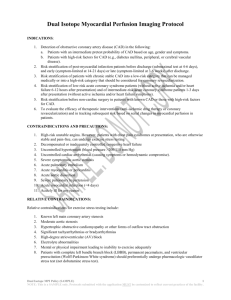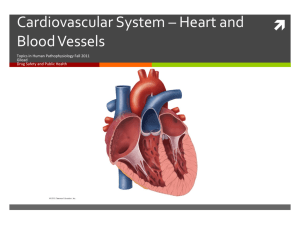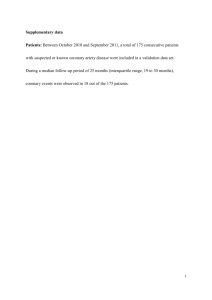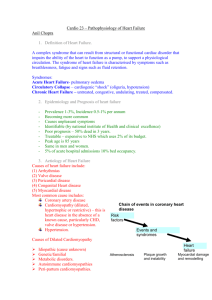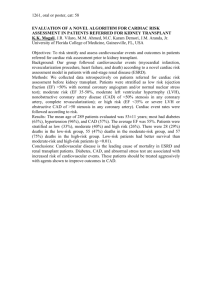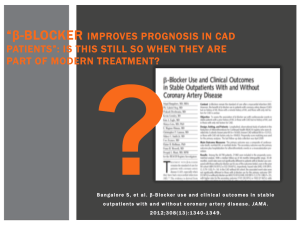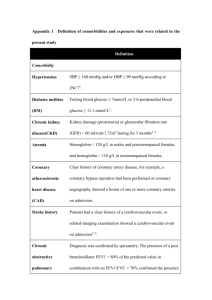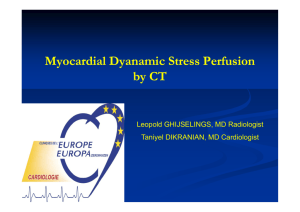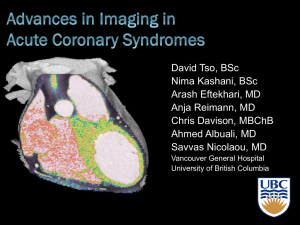XXXX Nuclear Cardiology Lab
advertisement
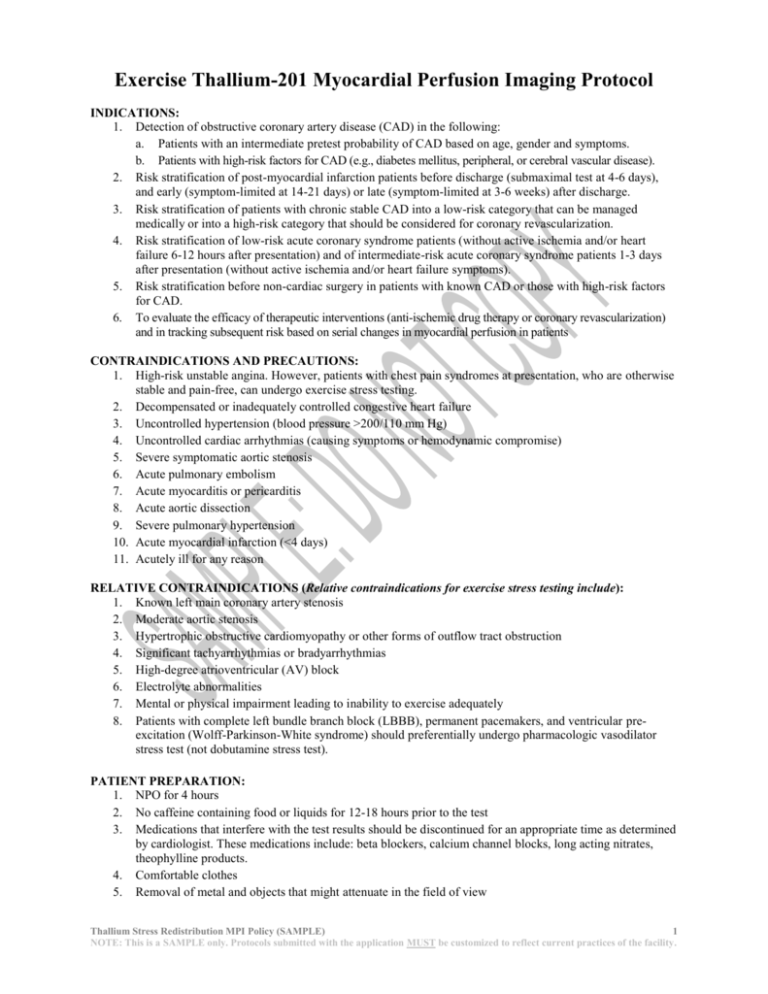
Exercise Thallium-201 Myocardial Perfusion Imaging Protocol INDICATIONS: 1. Detection of obstructive coronary artery disease (CAD) in the following: a. Patients with an intermediate pretest probability of CAD based on age, gender and symptoms. b. Patients with high-risk factors for CAD (e.g., diabetes mellitus, peripheral, or cerebral vascular disease). 2. Risk stratification of post-myocardial infarction patients before discharge (submaximal test at 4-6 days), and early (symptom-limited at 14-21 days) or late (symptom-limited at 3-6 weeks) after discharge. 3. Risk stratification of patients with chronic stable CAD into a low-risk category that can be managed medically or into a high-risk category that should be considered for coronary revascularization. 4. Risk stratification of low-risk acute coronary syndrome patients (without active ischemia and/or heart failure 6-12 hours after presentation) and of intermediate-risk acute coronary syndrome patients 1-3 days after presentation (without active ischemia and/or heart failure symptoms). 5. Risk stratification before non-cardiac surgery in patients with known CAD or those with high-risk factors for CAD. 6. To evaluate the efficacy of therapeutic interventions (anti-ischemic drug therapy or coronary revascularization) and in tracking subsequent risk based on serial changes in myocardial perfusion in patients CONTRAINDICATIONS AND PRECAUTIONS: 1. High-risk unstable angina. However, patients with chest pain syndromes at presentation, who are otherwise stable and pain-free, can undergo exercise stress testing. 2. Decompensated or inadequately controlled congestive heart failure 3. Uncontrolled hypertension (blood pressure >200/110 mm Hg) 4. Uncontrolled cardiac arrhythmias (causing symptoms or hemodynamic compromise) 5. Severe symptomatic aortic stenosis 6. Acute pulmonary embolism 7. Acute myocarditis or pericarditis 8. Acute aortic dissection 9. Severe pulmonary hypertension 10. Acute myocardial infarction (<4 days) 11. Acutely ill for any reason RELATIVE CONTRAINDICATIONS (Relative contraindications for exercise stress testing include): 1. Known left main coronary artery stenosis 2. Moderate aortic stenosis 3. Hypertrophic obstructive cardiomyopathy or other forms of outflow tract obstruction 4. Significant tachyarrhythmias or bradyarrhythmias 5. High-degree atrioventricular (AV) block 6. Electrolyte abnormalities 7. Mental or physical impairment leading to inability to exercise adequately 8. Patients with complete left bundle branch block (LBBB), permanent pacemakers, and ventricular preexcitation (Wolff-Parkinson-White syndrome) should preferentially undergo pharmacologic vasodilator stress test (not dobutamine stress test). PATIENT PREPARATION: 1. NPO for 4 hours 2. No caffeine containing food or liquids for 12-18 hours prior to the test 3. Medications that interfere with the test results should be discontinued for an appropriate time as determined by cardiologist. These medications include: beta blockers, calcium channel blocks, long acting nitrates, theophylline products. 4. Comfortable clothes 5. Removal of metal and objects that might attenuate in the field of view Thallium Stress Redistribution MPI Policy (SAMPLE) 1 NOTE: This is a SAMPLE only. Protocols submitted with the application MUST be customized to reflect current practices of the facility. 6. Using universal precautions, an IV is placed preferably in an antecubital vein for injection of the stress dose followed by a flush of 10 ml of normal saline. RADIOPHARMACEUTICALS/PHARMACEUTICALS: Identity: Thallium-201 (Tl-201) Dose: Stress – 2.5 – 4.0 mCi Route adm: Intravenous PROCEDURE: 1. Tl-201 is injected at peak exercise and the patient continues to walk for 1 minute 2. SPECT imaging must start within 10-15 minutes 3. The patient is positioned in the supine position with the left arm raised above the head 4. Images are obtained using the following parameters: Energy Window: 30% symmetric 70 keV; 20% symmetric 167 keV Collimator: Low Energy All Purpose (LEAP) Orbit: 180 degree (45 degree RAO to 45 degree LPO) Orbit type: Circular or noncircular depending on camera vendor Pixel size: 6.4 mm Acquisition type: Either step and shoot or continuous Number of projections: 32 preferred; 64 optional Matrix: 64 x 64 Time/projection: 40 seconds for 32 projections; 25 seconds for 64 projections ECG Gating: may be attempted Frames/cycle: 8 R – R window 100% 5. Following the stress images, the patient waits 3-4 hours. The patient should remain NPO during this time period. 6. Delay or redistribution imaging 3-4 hours later using the following parameters: Energy Window: 30% symmetric 70 keV; 20% symmetric 167 keV Collimator: Low Energy All Purpose (LEAP) Orbit: 180 degree (45 degree RAO to 45 degree LPO) Orbit type: Circular or noncircular depending on camera vendor Pixel size: 6.4 mm Acquisition type: Either step and shoot or continuous Number of projections: 32 (single head); 64 (dual head) Matrix: 64 x 64 Time/projection: 40 seconds (single head); 25 seconds (dual head) 7. The images are processed using the facilities usual myocardial perfusion quantitation software such as Cedars AutoQuant, Emory Cardiac Toolbox, 4DM SPECT or Wackers-Lui. Filters will vary per camera manufacturer and the lab should verify filters with the manufacturer. Filter backprojection with a Butterworth filter, order 5 and cut-off 0-0.5 (Gated 0.2, Non-gated 0.25) 8. In cases where the standard images show a fixed or minimally reversible perfusion abnormality, myocardial viability can be assess with additional rest imaging at 18- 24 hours. The time/projection may be increased to 50 seconds for 32 projections and 35 seconds for 64 projections. Note for IAC Accredited Facilities: All protocols must contain detailed, site-specific, camera specific instructions for: acquisition, processing, display and labeling. Thallium Stress Redistribution MPI Policy (SAMPLE) 2 NOTE: This is a SAMPLE only. Protocols submitted with the application MUST be customized to reflect current practices of the facility.
